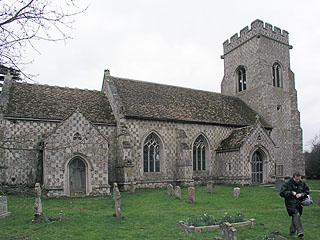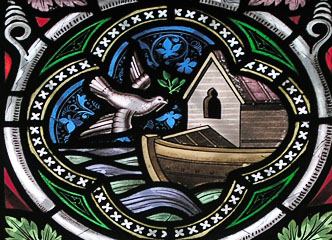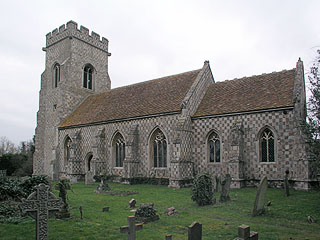When I saw the padlock on the door, I gave an inward groan. We'd had a rather fruitless day driving around the west of Cambridgeshire, finding many locked doors and very little information about how to get inside anywhere. People in this bit of the county seem much less willing to keep their churches open for visitors than they are elsewhere.
Peering in through the windows, though, it was clear that the problem at St John is more permanent than an unduly protective PCC, for it was obvious that the church was redundant. The nave has been stripped bare, and although there were stacking chairs arranged in rows, there were little of the signs of continuing worship.
Also clear was the fact that this is almost entirely a Victorian rebuilding. Apparently, there was a church here at Domesday [Mark adds: though now named for the Baptist it was apparently dedicated to St Peter - and presumably at some point dedicated to St Agnes since I can't see why this small place is called for her unless the church was hers - and it is surely too small a place to have had two churches?], but in 1848 the tower was entirely rebuilt, and the nave and chancel followed in 1854. Bits of the old churches have been reused - Pevsner suggests that the north doorway is 14th century, and the tower arch is 16th century. Still, there's not very much to see. The most unusual thing on the exterior is the peculiar decoration of the surfaces - it's all covered with a chequer pattern of whitish stone blocks alternating with panels of brown fieldstones. I really didn't like it at all, though Mark pointed out that it was probably just me being grumpy. I noted the ivy creeping up the walls, and prepared to write yet another sic transit entry.
Fortunately, my indignant musings were interrupted by the appearance of a bolt of lightning darting around my feet. It quickly turned into a greyhound, which stopped briefly before trying to play with Mark's trousers. It was followed by a very stately loping Afghan hound coming from round the corner of the chancel, and then by an owner. He stopped and chatted to us for a while, and told us a bit more about the church. We must have shown sufficient enthusiasm because he offered to postpone his walk and fetch the key to show us around the inside.
The story he told was heart-warming, and made me feel very mean-spirited about my earlier ill-temper. In the 70s, St John was declared redundant and very nearly pulled down - only a campaign by locals and the Friends of Friendless Churches managed to overturn the demolition order. A new trust was set up - the Friends of Papworth St Agnes Church - and they raised funds for restoration (after the declaration of redundancy, most of the interior had been stripped completely bare). By 1983, St John had undergone a transformation into a community hall. A celebratory Harvest Supper was held in the church on the 24th of September 1983, and it has become an annual event. It is also used as a community meeting place and for other events, as well as for occasional services.
Mark carried on chatting with him, while I had a poke around to see what I could see. The interior is nice and light and open - partially due to the destruction of the fittings, admittedly, but also the nice clear glass in the windows. The pulpit and font have survived.
For the most part, the architecture is very dull - indeed, the only feature I can really remember was inside the tower. For some reason, the architect decided to place a little circular stair turret in one corner, and so there is what looks like a little chimney shaft rising the whole height of the tower space. It is a little burst of whimsy in what is otherwise an inoffensive but rather dour building.
But then, architectural value isn't the point. If St John had been a medieval church, then there would have been an outcry if it had been condemned to demolition. People would have cited the marvellous angel roof, or the exquisite decoration of the 14th century arcades, or something. St John had none of that, and no doubt many people would think it somewhat unimportant if it had been knocked down. (Rather to my shame, I suspect that such thoughts were going through my mind as I grimaced at the awful chequered tower). Here, though, just the love of the villagers that saved the building. Because of that, it is now their own, and they make joyful use of it. Somehow, that seems very precious.
St John is kept locked. If you are interested in finding out more about
the church
and the events which it hosts, have a look at the Papworth St Agnes website.



